Abstract
Minced beef samples inoculated with Escherichia coli O157 were cultured in buffered peptone water supplemented with vancomycin, cefsulodin and cefixime (BPW-VCC) and subcultured to cefixime tellurite sorbitol MacConkey (CT-SMAC) agar both directly and after immunomagnetic separation (IMS) of the organism with magnetic beads coated with an antibody against E. coli O157 (Dynabeads anti-E. coli O157, Dynal, Oslo). E. coli O157 was recovered from initial inocula of 200 organisms/g by direct subculture and 2 organisms/g by IMS. Twelve strains of E. coli O157 of different combinations of phage type, H antigen and toxin genotype were all recovered from initial inocula of two organisms/g by IMS. Non-specific binding of other organisms to the magnetic beads could be reduced by washing of the beads in PBS with Tween-20 0.002-0.005% E. coli O157 was not bound by magnetic coated with an unrelated antibody. During investigation of a dairy herd that was possibly linked to a small outbreak of infection with E. coli O157, the organism was isolated from 2 of 279 forestream milk samples from individual cattle; both isolates were made only by the IMS technique. IMS is rapid, technically simple, and a specific method for isolation of E. coli O157 and will be useful in epidemiological studies.
Full text
PDF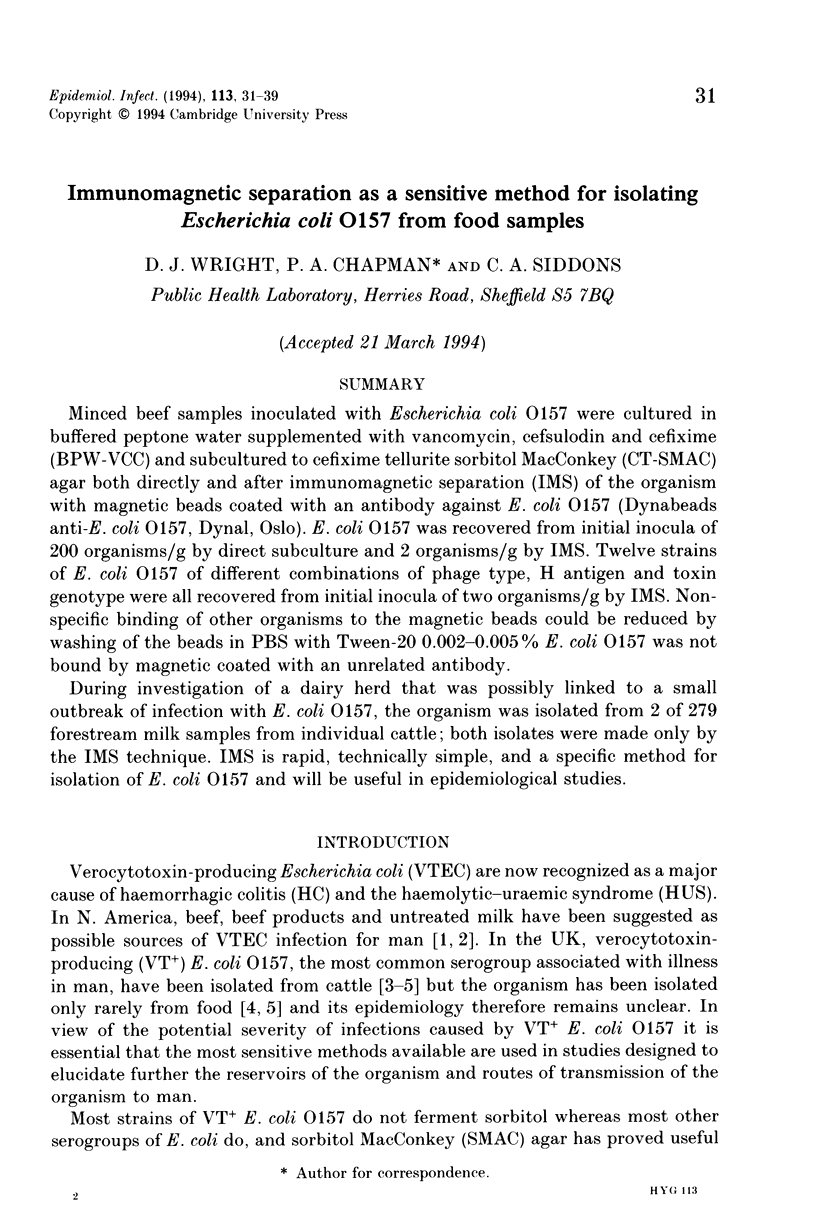
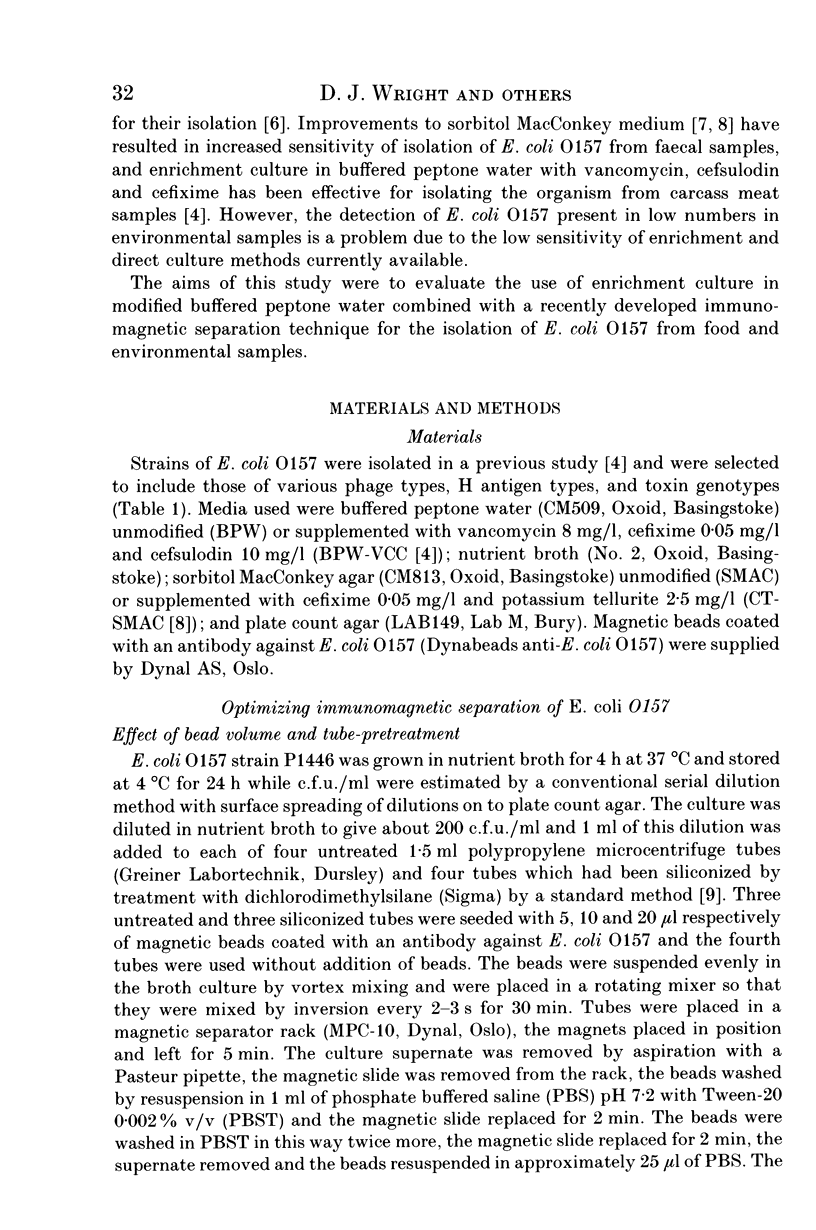
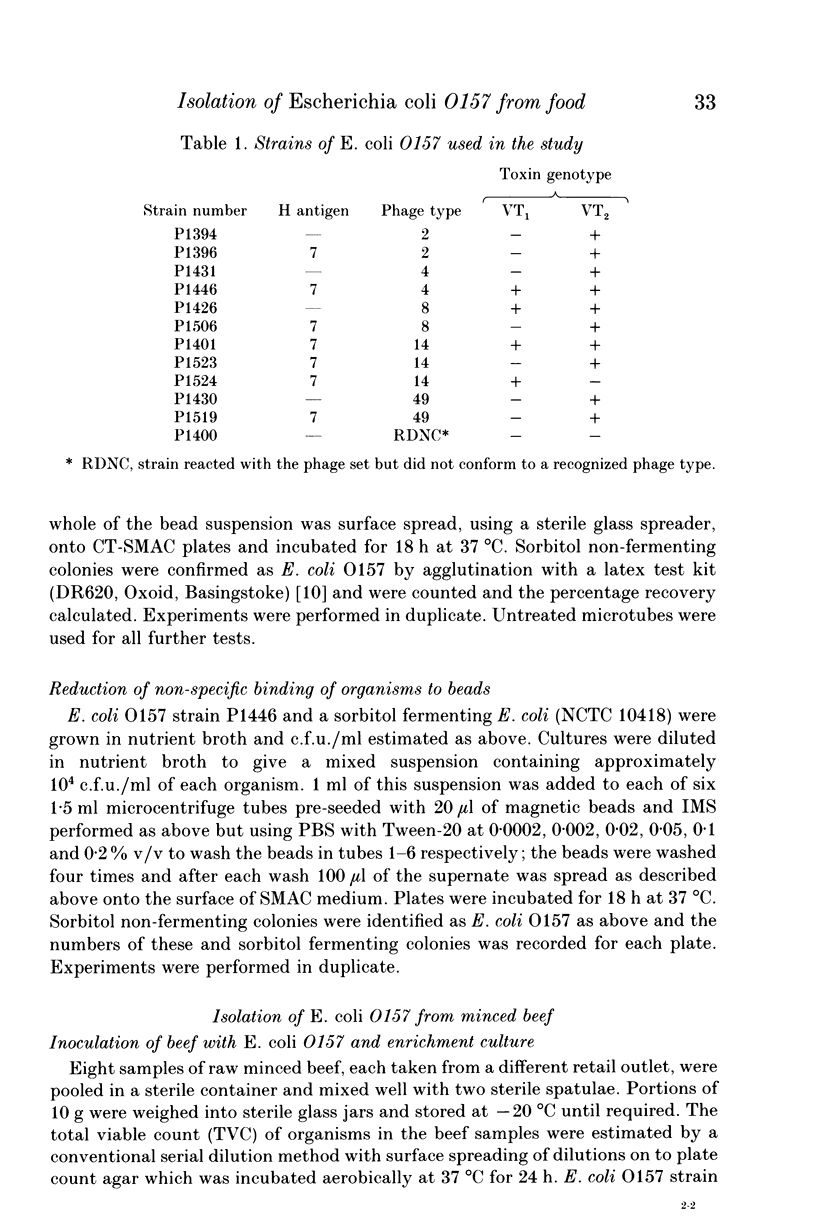
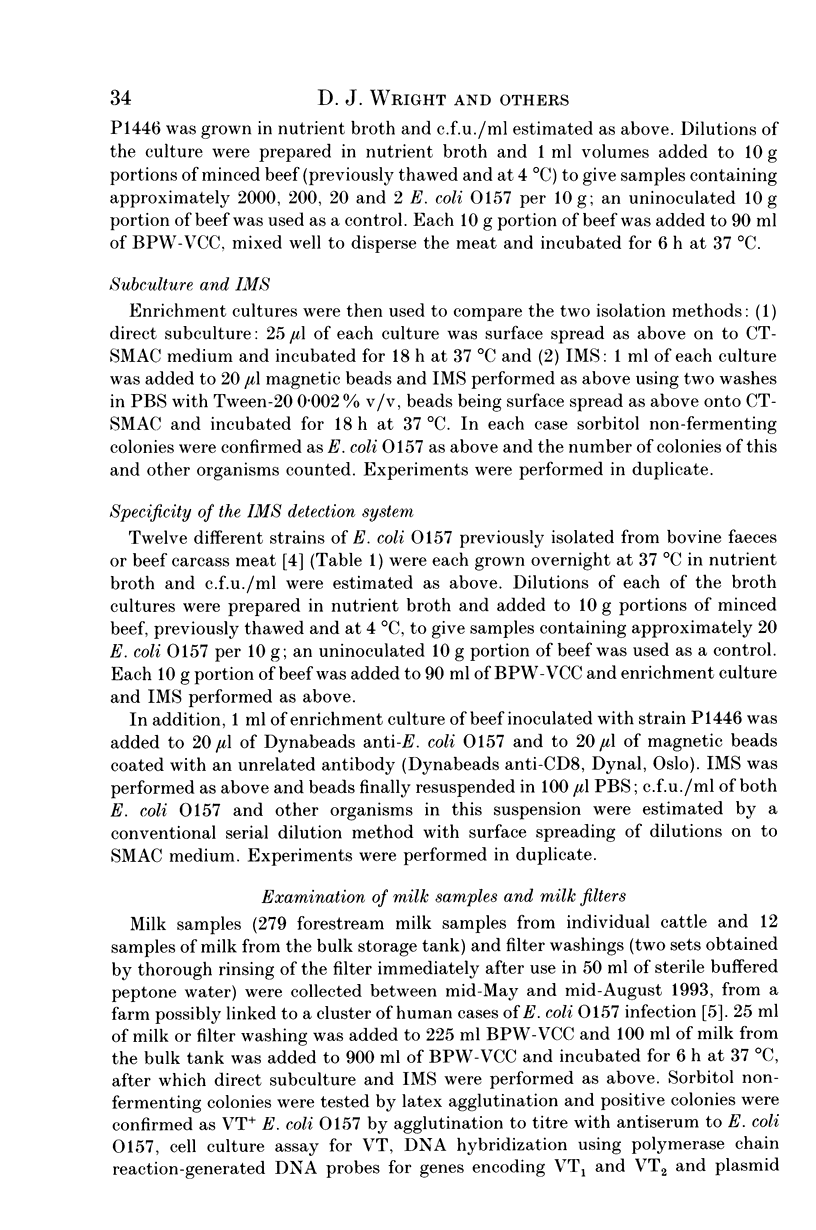
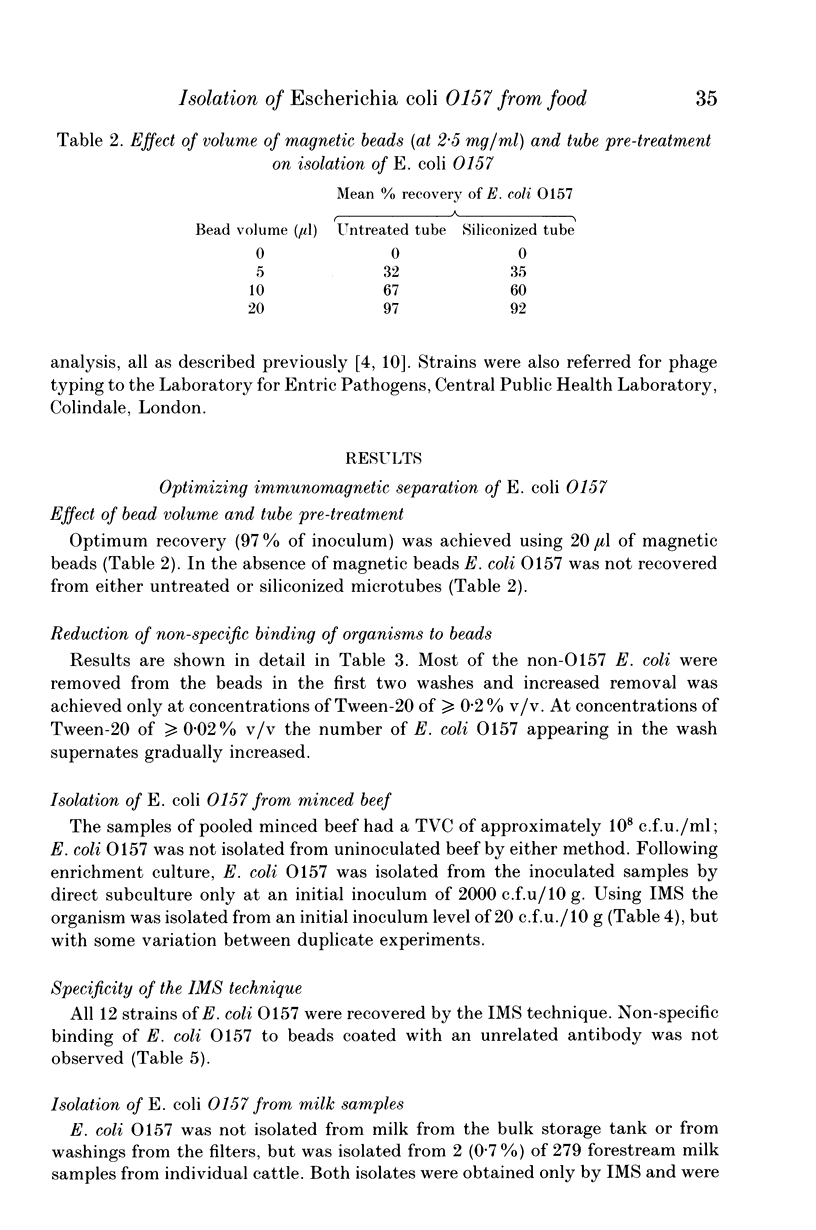
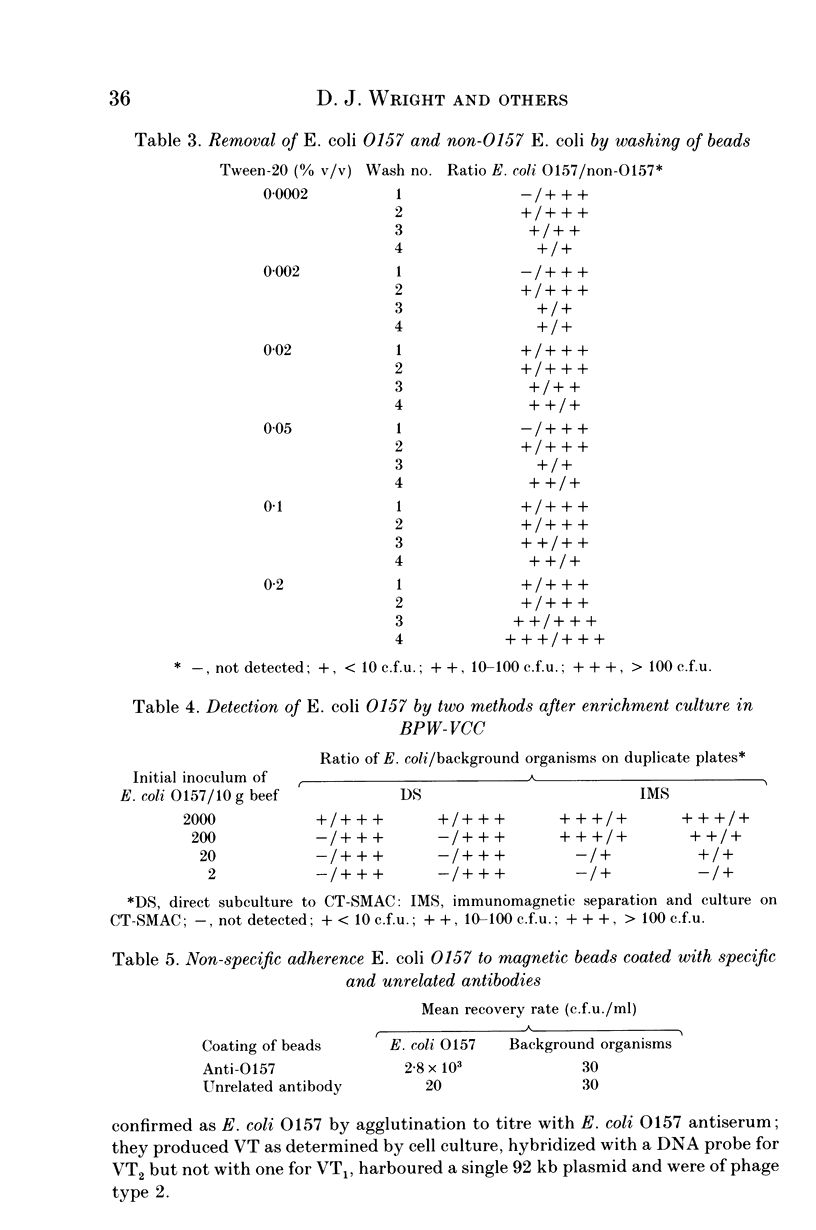
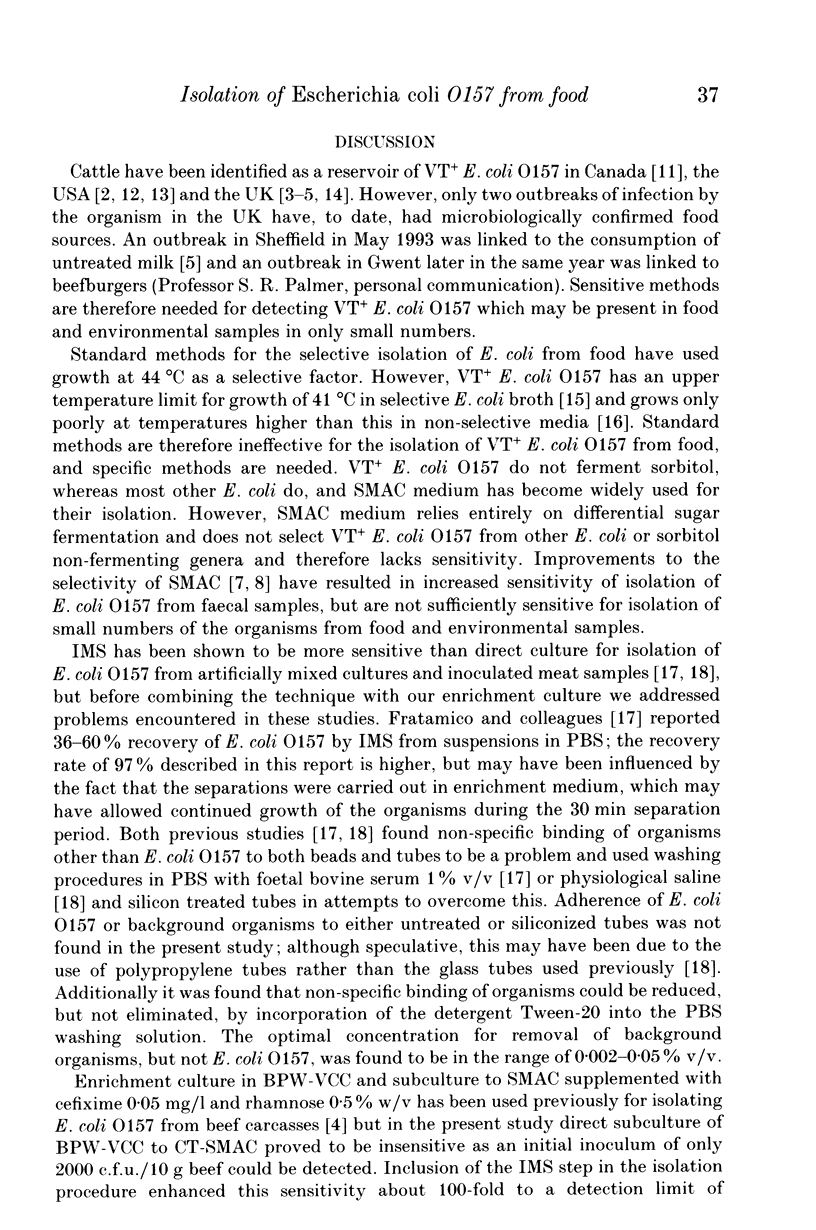
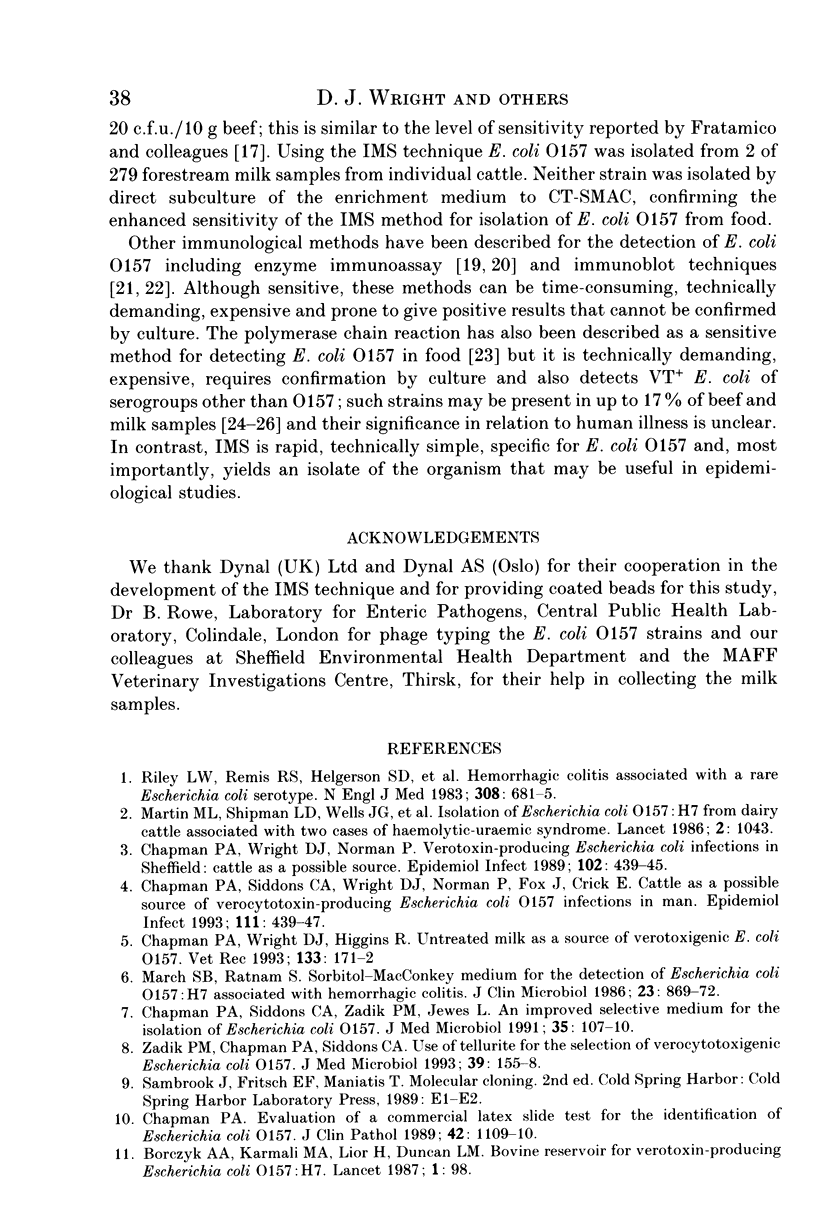
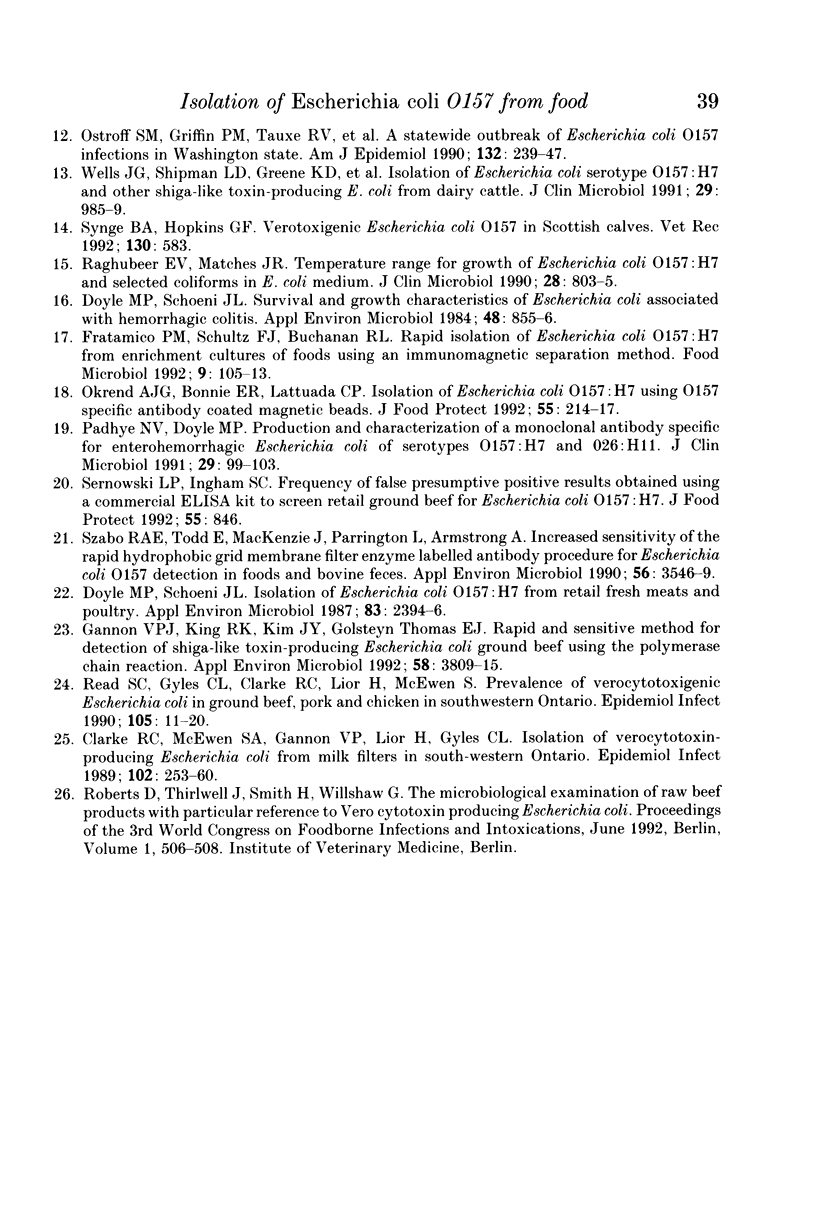
Selected References
These references are in PubMed. This may not be the complete list of references from this article.
- Borczyk A. A., Karmali M. A., Lior H., Duncan L. M. Bovine reservoir for verotoxin-producing Escherichia coli O157:H7. Lancet. 1987 Jan 10;1(8524):98–98. doi: 10.1016/s0140-6736(87)91928-3. [DOI] [PubMed] [Google Scholar]
- Chapman P. A. Evaluation of commercial latex slide test for identifying Escherichia coli O157. J Clin Pathol. 1989 Oct;42(10):1109–1110. doi: 10.1136/jcp.42.10.1109. [DOI] [PMC free article] [PubMed] [Google Scholar]
- Chapman P. A., Siddons C. A., Wright D. J., Norman P., Fox J., Crick E. Cattle as a possible source of verocytotoxin-producing Escherichia coli O157 infections in man. Epidemiol Infect. 1993 Dec;111(3):439–447. doi: 10.1017/s0950268800057162. [DOI] [PMC free article] [PubMed] [Google Scholar]
- Chapman P. A., Siddons C. A., Zadik P. M., Jewes L. An improved selective medium for the isolation of Escherichia coli O157. J Med Microbiol. 1991 Aug;35(2):107–110. doi: 10.1099/00222615-35-2-107. [DOI] [PubMed] [Google Scholar]
- Chapman P. A., Wright D. J., Higgins R. Untreated milk as a source of verotoxigenic E coli O157. Vet Rec. 1993 Aug 14;133(7):171–172. doi: 10.1136/vr.133.7.171. [DOI] [PubMed] [Google Scholar]
- Chapman P. A., Wright D. J., Norman P. Verotoxin-producing Escherichia coli infections in Sheffield: cattle as a possible source. Epidemiol Infect. 1989 Jun;102(3):439–445. doi: 10.1017/s0950268800030156. [DOI] [PMC free article] [PubMed] [Google Scholar]
- Clarke R. C., McEwen S. A., Gannon V. P., Lior H., Gyles C. L. Isolation of verocytotoxin-producing Escherichia coli from milk filters in south-western Ontario. Epidemiol Infect. 1989 Apr;102(2):253–260. doi: 10.1017/s0950268800029927. [DOI] [PMC free article] [PubMed] [Google Scholar]
- Doyle M. P., Schoeni J. L. Isolation of Escherichia coli O157:H7 from retail fresh meats and poultry. Appl Environ Microbiol. 1987 Oct;53(10):2394–2396. doi: 10.1128/aem.53.10.2394-2396.1987. [DOI] [PMC free article] [PubMed] [Google Scholar]
- Doyle M. P., Schoeni J. L. Survival and growth characteristics of Escherichia coli associated with hemorrhagic colitis. Appl Environ Microbiol. 1984 Oct;48(4):855–856. doi: 10.1128/aem.48.4.855-856.1984. [DOI] [PMC free article] [PubMed] [Google Scholar]
- Gannon V. P., King R. K., Kim J. Y., Thomas E. J. Rapid and sensitive method for detection of Shiga-like toxin-producing Escherichia coli in ground beef using the polymerase chain reaction. Appl Environ Microbiol. 1992 Dec;58(12):3809–3815. doi: 10.1128/aem.58.12.3809-3815.1992. [DOI] [PMC free article] [PubMed] [Google Scholar]
- March S. B., Ratnam S. Sorbitol-MacConkey medium for detection of Escherichia coli O157:H7 associated with hemorrhagic colitis. J Clin Microbiol. 1986 May;23(5):869–872. doi: 10.1128/jcm.23.5.869-872.1986. [DOI] [PMC free article] [PubMed] [Google Scholar]
- Martin M. L., Shipman L. D., Wells J. G., Potter M. E., Hedberg K., Wachsmuth I. K., Tauxe R. V., Davis J. P., Arnoldi J., Tilleli J. Isolation of Escherichia coli O157:H7 from dairy cattle associated with two cases of haemolytic uraemic syndrome. Lancet. 1986 Nov 1;2(8514):1043–1043. doi: 10.1016/s0140-6736(86)92656-5. [DOI] [PubMed] [Google Scholar]
- Ostroff S. M., Griffin P. M., Tauxe R. V., Shipman L. D., Greene K. D., Wells J. G., Lewis J. H., Blake P. A., Kobayashi J. M. A statewide outbreak of Escherichia coli O157:H7 infections in Washington State. Am J Epidemiol. 1990 Aug;132(2):239–247. doi: 10.1093/oxfordjournals.aje.a115653. [DOI] [PubMed] [Google Scholar]
- Padhye N. V., Doyle M. P. Production and characterization of a monoclonal antibody specific for enterohemorrhagic Escherichia coli of serotypes O157:H7 and O26:H11. J Clin Microbiol. 1991 Jan;29(1):99–103. doi: 10.1128/jcm.29.1.99-103.1991. [DOI] [PMC free article] [PubMed] [Google Scholar]
- Raghubeer E. V., Matches J. R. Temperature range for growth of Escherichia coli serotype O157:H7 and selected coliforms in E. coli medium. J Clin Microbiol. 1990 Apr;28(4):803–805. doi: 10.1128/jcm.28.4.803-805.1990. [DOI] [PMC free article] [PubMed] [Google Scholar]
- Read S. C., Gyles C. L., Clarke R. C., Lior H., McEwen S. Prevalence of verocytotoxigenic Escherichia coli in ground beef, pork, and chicken in southwestern Ontario. Epidemiol Infect. 1990 Aug;105(1):11–20. doi: 10.1017/s0950268800047592. [DOI] [PMC free article] [PubMed] [Google Scholar]
- Riley L. W., Remis R. S., Helgerson S. D., McGee H. B., Wells J. G., Davis B. R., Hebert R. J., Olcott E. S., Johnson L. M., Hargrett N. T. Hemorrhagic colitis associated with a rare Escherichia coli serotype. N Engl J Med. 1983 Mar 24;308(12):681–685. doi: 10.1056/NEJM198303243081203. [DOI] [PubMed] [Google Scholar]
- Synge B. A., Hopkins G. F. Verotoxigenic Escherichia coli 0.157 in Scottish calves. Vet Rec. 1992 Jun 27;130(26):583–583. doi: 10.1136/vr.130.26.583-a. [DOI] [PubMed] [Google Scholar]
- Szabo R., Todd E., MacKenzie J., Parrington L., Armstrong A. Increased sensitivity of the rapid hydrophobic grid membrane filter enzyme-labeled antibody procedure for Escherichia coli O157 detection in foods and bovine feces. Appl Environ Microbiol. 1990 Nov;56(11):3546–3549. doi: 10.1128/aem.56.11.3546-3549.1990. [DOI] [PMC free article] [PubMed] [Google Scholar]
- Wells J. G., Shipman L. D., Greene K. D., Sowers E. G., Green J. H., Cameron D. N., Downes F. P., Martin M. L., Griffin P. M., Ostroff S. M. Isolation of Escherichia coli serotype O157:H7 and other Shiga-like-toxin-producing E. coli from dairy cattle. J Clin Microbiol. 1991 May;29(5):985–989. doi: 10.1128/jcm.29.5.985-989.1991. [DOI] [PMC free article] [PubMed] [Google Scholar]
- Zadik P. M., Chapman P. A., Siddons C. A. Use of tellurite for the selection of verocytotoxigenic Escherichia coli O157. J Med Microbiol. 1993 Aug;39(2):155–158. doi: 10.1099/00222615-39-2-155. [DOI] [PubMed] [Google Scholar]


